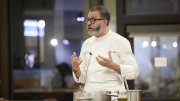In the weeks and months after Donald Trump’s second inauguration, the number “3.5 percent” kept showing up—like a mantra, or maybe a prayer—in different corners of the internet. It was repeated in social media posts, long Reddit threads, online newsletters, political podcasts, videos, and the websites of activist organizations. “The Hopeful Math for Saving Democracy,” proclaimed a headline in Ms. Magazine. In his newsletter, independent journalist Dan Froomkin asked, “Is there a magic number for the resistance?”—and answered with that familiar figure.

A decade ago, academic research found that authoritarian governments around the world have almost always been forced to yield when mass-resistance campaigns manage to mobilize 3.5 percent of a country’s population during a “peak” event. In the activist community, one organizer told me, it’s become “kind of a golden rule.”
The person behind that finding is Erica Chenoweth, the Stanton professor of the First Amendment at the Harvard Kennedy School (HKS), who studies nonviolent civil resistance against authoritarianism—where it has worked, where it hasn’t, and why. Chenoweth directs the Nonviolent Action Lab at HKS, which supports civil resistance using social-science research tools—including the world’s largest dataset tracking the characteristics and outcomes of mass uprisings around the globe.
There’s long been a hunger for hard numbers to quantify democracy, a concept that’s as fundamental as it is messy and impermanent. That hunger has become even more intense now, in a moment when, in countries around the globe, democracy seems increasingly fragile. This is perhaps why data-driven research like Chenoweth’s is so in demand right now, and why the findings can be both anxiety-inducing and comforting.
For instance, political science scholarship suggests that democracies are remarkably stable—from year to year, the chance that one will fall apart is minuscule, says Hardy Merriman, the former president of the Washington, D.C.-based International Center on Nonviolent Conflict (ICNC). But since the mid-2000s, there has been a striking increase in what scholars call “democratic backsliding,” as authoritarian regimes and elected leaders with authoritarian tendencies roll back freedoms and consolidate power. Once backsliding begins, the data show, democracies are surprisingly ineffectual at stopping it. In one study of 96 backsliding episodes between 1900 and 2019, political scientists at the Sweden-based V-Dem Institute found that nearly 70 percent of the countries broke down completely into authoritarian rule. But studies have also found that, especially over the last 30 years, most countries that broke down into authoritarianism eventually managed to pull a U-turn.
Working with other researchers, Chenoweth has been able to pinpoint some predictors of a resistance movement’s victory. It turns out that organizational leadership and skills training sometimes matter more than money, and that boycotts and strikes often weaken a regime even more than massive demonstrations. Along with Zoe Marks, an HKS lecturer in public policy (and Chenoweth’s spouse), Chenoweth has found that more participation from women in a movement correlates to much greater success.
After decades of thinking about large-scale civil resistance campaigns in places like Poland, Indonesia, and South Africa, Chenoweth’s thoughts have lately been running much closer to home. Although political scientists debate how acute the erosion of democracy has been in the United States, many have been sounding ever-more-sharp alarms since the start of President Donald Trump’s second term. That’s why Chenoweth’s inbox, never exactly under control, began to explode in recent months—often with emails asking precisely where the United States stands.
“It is very disorienting for people, because they expect one morning to wake up and the sun is not out,” Chenoweth, who uses they/them pronouns, said recently on MSNBC host Chris Hayes’s podcast. The reality is more complicated; there’s no single moment when a country becomes authoritarian, and the recognition is usually gradual. “Most people’s lives just kind of keep going until all of a sudden, they realize stuff is happening that is much less predictable,” Chenoweth explained. “The sense of fear and social silencing happens even before people know.”
“Where do we stand?” was my question, too, when I met Chenoweth in mid-April at their office. The room felt bright and orderly—books neatly on the shelves, a stack of papers on the desk, two cushioned armchairs by the window. A few days earlier, the U.S. Supreme Court had unanimously ordered the Trump administration to facilitate the return of Kilmar Abrego Garcia, the Venezuelan immigrant whom the government admitted to having wrongly sent to a notorious prison in El Salvador. The administration appeared to be ignoring the order, without explicitly saying so. (At press time, Abrego Garcia had just been returned to the U.S.)
“It feels like we’ve crossed a line this week,” I said to Chenoweth. “Haven’t we?”
Chenoweth, 45, who wears neckties and a spiky, close-cropped haircut and exudes a sense of studied calm, listened to my question and smiled. “Which line is it that you think we’ve crossed this week?”
A Database of Resistance
A jarring childhood encounter taught Chenoweth early on that even supposedly strong democracies can slip into authoritarian behavior. They grew up in Ohio but spent summers in Santa Fe, New Mexico, where their parents were professional musicians in the orchestra (dad played French horn, mom played flute). The housing development where the family stayed had popped up in the 1950s, built by a developer who’d purchased the land for cheap from the federal government.
One day when Chenoweth was nine or 10, they were digging in the backyard with their brother and unearthed some pottery. “We didn’t know its origins, so we took it to the public library, which was what you did in those days,” Chenoweth says. The librarian told them the pottery looked Japanese, and then she explained to the children that their house had been built on the site of a former internment camp. “She said that the Japanese families who were interned there often gardened,” Chenoweth explains, “which helped us understand why we had such amazing, mature plants in our yard.” All of this was stunning new information for Chenoweth, who remembers the librarian pulling book after book off the shelves, showing them photos of the camps and their inhabitants.
A couple of summers later, Chenoweth’s mother gave them a book, Zlata’s Diary, written by the so-called “Anne Frank of Sarajevo”: Zlata Filipović, a young girl almost exactly Chenoweth’s age, who had documented her daily life under siege during the Bosnian War. “I read it and was just so moved by the story,” Chenoweth says. “And I couldn’t wrap my mind around why the adults couldn’t get this conflict, this violence, sorted out.”
Chenoweth went to college at the University of Dayton, where they considered joining the ROTC as a path to becoming a diplomat. Then, during Chenoweth’s senior year, 9/11 happened. Chenoweth was in the middle of submitting graduate school applications, and at the University of Colorado the following fall, they embarked on a Ph.D. in terrorism studies and wrote a dissertation on terrorist attacks in democratic countries.
In 2006, during their last year of grad school, Chenoweth attended a workshop organized by the ICNC. Over four days, participants read books and articles making the claim that civil resistance could be even more effective than armed revolt. This argument was mostly based on case studies: the Optor movement in Serbia that brought down Slobodan Milošević, the People Power movement in the Philippines that ousted Ferdinand Marcos, Poland’s Solidarity movement, the American civil rights movement.
Chenoweth kept thinking about places where nonviolent popular resistance had failed: Tiananmen Square, the Hungarian uprising of 1956, Burma (Myanmar) in 1988. Surely the successes were outliers? Had anyone actually studied this systematically?
One of the other workshop attendees was a political scientist named Maria Stephan, who challenged Chenoweth to come up with a study that would test the argument to Chenoweth’s satisfaction. Within a day, the two had a rough research proposal sketched out. They spent the next few years implementing it together, building a database called Nonviolent and Violent Campaigns and Outcomes, or NAVCO. The intention was to assess every attempted mass rebellion from 1900 to 2006, determining the degree to which it had succeeded or failed, and the reasons why.
To make sure the data was rigorous enough to withstand Chenoweth’s skepticism, the researchers set strict rules: they’d include only “maximalist” campaigns that involved at least 1,000 participants and sought to overthrow an oppressive regime, not just reform it. And the movement would be considered successful only if it achieved its goal within one year of peak mobilization, and without material aid from outside the country. These restrictions meant that the U.S. civil rights movement wasn’t included in NAVCO and that India’s struggle for independence—whose leader, Mahatma Gandhi, coined the term “civil resistance,” and which served as a template for countless nonviolent insurgencies around the world—counted as only a partial success, because it took more than a year to push the British out.
Chenoweth and Stephan gathered information from thousands of sources: encyclopedias, bibliographies, case studies, historical documents, news reports, and other scholars’ published lists of popular revolutions. After two years, they had 323 campaigns in the database. Then Chenoweth ran the numbers. More than half of the civil resistance movements were successful, compared to only about a quarter of armed rebellions. And there seemed to be no statistical link with structural factors like geography, wealth, military power, or demographics—elements that scholars had previously considered fateful. What’s more, they found that nonviolent campaigns were 10 times more likely than violent ones to produce democracies within five years, even if they failed to oust their opponents in the short term.
In 2011, Chenoweth and Stephan published their findings in Why Civil Resistance Works: The Strategic Logic of Nonviolent Conflict, combining numerical data with detailed case studies. (Chenoweth presented the 3.5 percent principle two years later, in a TED Talk.) In general, Chenoweth and Stephan found, successful civil resistance movements had four essential ingredients: They mobilized mass participation by diverse groups of people, who stayed involved over time. They induced defections among those with power in the regime—economic and business elites, state media officials, security forces, and sometimes even members of the opposition party. They varied their methods to keep the pressure up, relying not only on protests but also strikes, boycotts, work slowdowns or outright stoppages, sit-ins, civil disobedience, and other forms of noncooperation. In Latin American countries, people have banged pots and pans in the streets or in their own homes—cacerolazos, or casserole demonstrations—creating a cacophony both impossible to ignore and difficult to target. And, lastly, successful movements were able to maintain discipline in the face of escalating repression without falling apart or turning to violence.
“The power of the research was in being able to show that ordinary people can stand up to repressive regimes and prevail, and that there is a very powerful set of methodologies and tactics that can allow people who are seemingly in a weaker position to fight back and win,” says Stephan. “For me, that has always been the most compelling and empowering aspect of the entire field of civil resistance.”
That’s how Daniel Hunter sees it, too. A New Jersey–based activist who has worked with nonviolent resistance movements in Africa and Southeast Asia, Hunter runs a civil-resistance training organization called Choose Democracy, which he founded in 2020, just as that year’s U.S. presidential election was heating up. Five years later, he says, Americans’ desire to organize is even more intense. When we spoke in late April, Hunter estimated that since Trump’s inauguration, he and the network of activists he collaborates with, called Freedom Trainers, had given trainings, online and in person, to 20,000 people. Chenoweth’s research is an integral part of his presentations.
“The gift of Erica’s work is that it gave us numbers on the strategic wisdom of nonviolent action,” says activist Daniel Hunter.
“The gift of Erica’s work is that it gave us numbers on the strategic wisdom of nonviolent action, as opposed to arms and guerilla-style resistance,” he says. “That allows for the widest participation, because more people can see themselves in a movement that is nonviolent.”
Chenoweth’s work also gets at something even more basic, Hunter says. Often, before he can begin training people in resistance tactics, he has to convince them that it’s possible to do anything at all. “The psychological condition of authoritarianism is a feeling of, ‘Me on my own, what can I do?’” he says. “There’s this very heavy feeling for many people of overwhelm, a distraught sense of isolation, of being too small, too powerless.” That’s where the research comes in. Showing the NAVCO numbers and case studies—and data points like the 3.5 percent principle—gives him a way to “connect and help people identify their power,” he says, “and identify the relationships they can pull on and trust and get in motion with, together.”
The Autocrats’ Network
Several years ago, Chenoweth, who has continued updating and refining the NAVCO database, began noticing that the effectiveness of civil resistance movements around the world seemed to be declining. In the 1990s, the success rate reached a high-water mark of 65 percent. But since 2010, that number has fallen to below 34 percent. And in at least two countries, Bahrain and Brunei, movements failed even after mobilizing the “magic” number of 3.5 percent of their populations—one of several caveats that leads Chenoweth to caution that the 3.5 percent principle is a “rule of thumb,” not a prescriptive certainty. (Another is that, in absolute terms, 3.5 percent can be a huge number; in the United States, it’s nearly 12 million people.)
At first Chenoweth wondered if this decline might be a statistical effect—nonviolent resistance is now the dominant method of insurgency, and there have been more campaigns in the past 25 years than there were in the previous 100. But armed resistance has been losing effectiveness, too, and those campaigns are fewer and fewer. Something else, Chenoweth realized, must be going on.
Just what is the subject of a book in progress now, tentatively titled “The End of People Power.” Chenoweth sees a number of factors at work, such as regimes managing to control the information environment, or provoking violence within a movement to discredit it, or criminalizing protest. There is also a growing tendency for resistance campaigns to rely on street protests alone. In the digital era, when it’s easier than before to get thousands of people in the streets, demonstrations don’t project the same sense of urgency and crisis, Chenoweth says. Even more significant, defections among regime supporters, especially security forces, are declining.
Chenoweth often recounts how, in 2000, when Serbians from all over the country converged on Belgrade to demand Milošević leave power, police officers stationed outside the presidential palace ignored an order to fire on the demonstrators. Later, when scholars and reporters asked why they didn’t shoot, Chenoweth says, “They said things like, ‘I thought I saw my friend in the crowd,’ or ‘I thought I saw my cousin.’…They realized their long-term interests lay with those in front of them rather than the guy behind them.”
Authoritarian governments have learned from experiences like that, Chenoweth says, and begun training their soldiers and police to harden them against this impulse. They purge officers whose loyalty isn’t absolute; in some cases, leaders simply delegate the worst repression to mercenaries. “So, for example, Saudi Arabia provided troops in Bahrain,” they explain. “Belarus has provided security advisers in Venezuela; Russia has provided troops in Kazakhstan.”
Which brings Chenoweth to another factor: increasingly, autocrats around the world are coordinating, sharing lessons, sharing intelligence, sharing resources. “Many of the activists that I talk with say they feel now that when they’re going up against their government, they’re actually going up against a massive global coalition,” Chenoweth told an audience last year at the University of Oxford. “And that is very difficult to do alone.”
To be successful, Chenoweth says, civil resistance movements will have to adapt. If security forces are unlikely to defect, then activists need to concentrate on peeling away economic elites or other segments of society that may be more “wobbly.” Chenoweth’s recent research, with colleagues Zoe Marks and Andrew Hocking, has shown that this kind of strategic targeting can trigger a cascade of defections that yields big successes with even the smallest numbers of participants. At the Nonviolent Action Lab, Chenoweth and their team have been studying whether AI tools might help movements gather intelligence, develop strategies, and analyze regime allies to find potential weak spots.
It’s also important, Chenoweth says, to keep in mind an older, simpler math: the power of one-on-one organizing. On the day I visited their office, a gray spring morning in Cambridge, Chenoweth kept thinking about their mentor, James Lawson, the American civil rights strategist who studied with Gandhi in India and led lunch-counter sit-ins in Nashville that became a model for the movement. Before planning an action, Chenoweth explains, “he would go into people’s homes and listen, day after day, for months.”
It was slow, steady work, and it made all the difference—in the boycotts he organized that drew massive, vigorous participation, and the marches and sit-ins where volunteers stayed strong, despite violent retaliation. “He was known for training whole communities, getting them ready for extremely dangerous methods of nonviolent resistance,” Chenoweth says. Working one on one, Lawson cemented bonds that built a movement. Behind the data in Chenoweth’s research, the statistics and percentages that help guide today’s pro-democracy activists, are people like him, and the people he organized. “That moral clarity and discipline and willingness to work in deep collaboration—,” Chenoweth pauses. “That’s very needed right now.”









